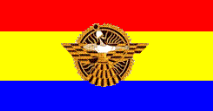Matbaa
 | |
| Official language | Neo-Aramaic (official), English (administrative) |
|---|---|
| Capital | Matbaa |
| Largest cities | Beth Sanaar, Merdin, Bani Yas |
| Website | MatbaaWiki |
| Forum | Matbaic Forums |
| Number of citizens | 8 |
| Number of active citizens | 0 (Nation Inactive) |
| Date founded | December 2nd 2005 |
| Government | Theocracy |
| Current leader | His Holiness Sfeir-Mikaelos I |
| Currency | Matbaic Salar |
| National animal | unknown |
| National fruit/food | Fig |
| National drink | unknown |
 | |
| Map versions | 8.0.1 - 11.6 |
The Zatriarchate of Matbaa was an Assyrian-themed micronation founded by Maximos on December 2nd 2005. Its theme was originally a general satire of theocratic nations hence the name 'Zatriarch' as opposed to 'Patriarch' but later retained these early idiosyncracies as it developed an Assyrian culture throughout its existence. Matbaa was one of the few stable nations throughout the MCS-GSO split and pursued an isolationist foreign policy which made it many enemies, most famously Woodstania and Babkha. The nation occupied land on Cibola and Tapfer after it left the CIS, dying after Matbaa was split into two seperate nations under the reign of Zatriarch Mikaelos-Sfeir (Pete James) in 2007.
History
Foundation and CIS era
Golden Age
Age of Conflict
Matbaic Split and Decline
Government
The Matbaic National Khanaushia (Aramaic: ܟܟܢܢܐܘܫܝܗ) was the highest legislative body in the entire nation. The Khanaushia comprised of government officials and ministers, and was presided over by the Zatriarch and Grand Vizier. There was no post of speaker, as every minister in the Khanaushia, as well as the Zatriarch and Grand Vizier, could propose legislation which was then debated and voted on. Amendments to legislation were also conducted in the Khanaushia. Because the Zatriarchate was a theocracy, its leader, the Zatriarch, was not appointed by the Khanaushia but by the Ecumenical Synod. This thus gave the Church a strong hold over government in the nation and ensured that the government coincides with the Clergy's interests. Although he was not an absoloute ruler, the Zatriarch could dismiss any minister except the Grand Vizier but only if he had the consent of the Matbaic Orthodox Ecumenical Synod. The Khanaushia members could overrule a decision by a two-thirds majority vote. As leader of the faith and henceforth carrying out the wishes of the Ecumenical Synod, the Zatriarch maintained divine right in ruling the nation and could veto legislation if it was not in keeping with church wishes.
The Grand Vizier was responsible for acting as a mediator between the church element of the Khanaushia, the Zatriarch, and the State Element, the Ministers. The Grand Vizier also had a seat in the synod to ensure that both government bodies (the Khanaushia and Synod) had a say in legislation and the running of the nation.
Culture & Religion
Culture
Matbaa's unusual cultural theme was perhaps its most interesting feature and some micronationalists remarked that they learnt about Assyrian culture through their participation in the Zatriarchate. Even more remarkable was that only one Matbaic citizen was ever actually ethnically Assyrian- the cultural simulation was a learning curve for most Matbaics. Nonetheless Matbaa legally recognised the Assyrian genocide and actively commemorated it, adopted a modified version of the Assyrian national anthem, and required that all its citizens take usernames in Neo-Aramaic.
The implementation of Aramaic culture was overseen by the Aramaic Institute, which also provided documents on Ancient Assyria and ensured that citizens had enough knowledge of Assyrian culture to actively participate in Matbaic cultural life. More specifically, Matbaa's culture was Syriac rather than Assyrian or Chaldean (though all fall under the ethnolinguistic group of 'Neo-Aramaic'), based on the Turoyo speaking Assyrian Christians of Syria and Turkey. In general Matbaic culture, as it was not founded originally as an Assyrian nation and only adopted these cultural traits later, was something of a mix of all Middle-Eastern cultures. Armenian was widely spoken and a programme of Armenian Cultural development was initiated by Grand Vizier Armen Sourenian, and there was also a large Sephardic Jewish population in Matbaa. Interest in Ancient Assyria also rose towards the end of Matbaa's life. Generally, this subject had been avoided as part of a concerted effort to remind people that Assyrians still existed as a macronational ethnic group, but Matbaa later proudly adopted this new ancient Assyrian identity, even going so far as to design a new national flag displaying the ancient Assyrian deity Ashur. Matbaics also began to take an interest in the Aramaic language, with the nation's official motto being Marth Assur D'Mikras (Mother Assyria of Micras). Babkha used this new-found interest in ancient Assyria to mock Matbaa, citing the Battle of Nineveh of 612 BC in which Persia annexed Neo-Assyria, as proof of Babkhan superiority over Matbaa.
In general Matbaa's cultural focus was its strength and also its weakness. Over its history Matbaa's culture made it stand out from other micronations but also put many prospective citizens off, feeling its culture too complex and making them unable to participate.
